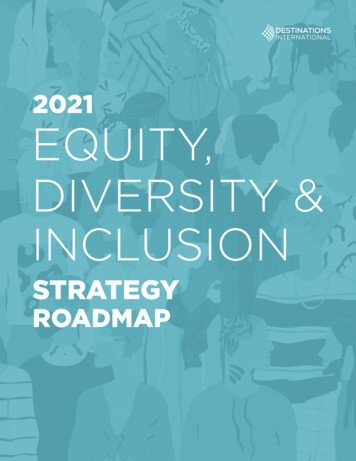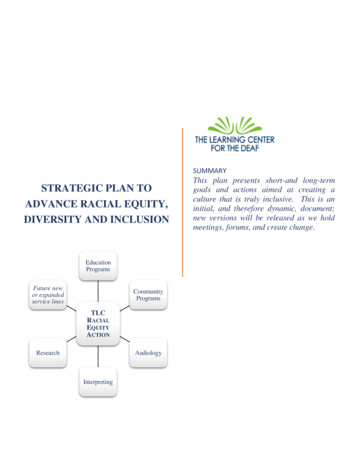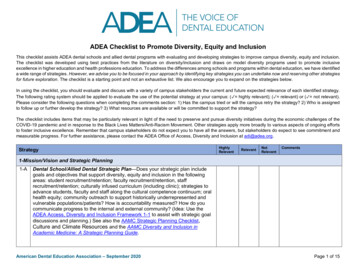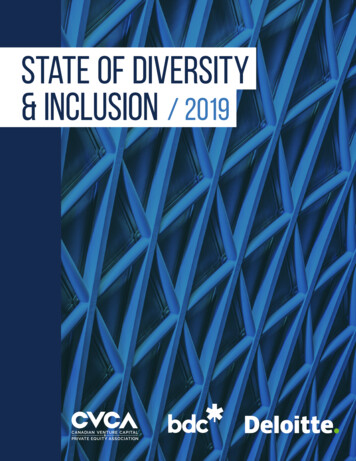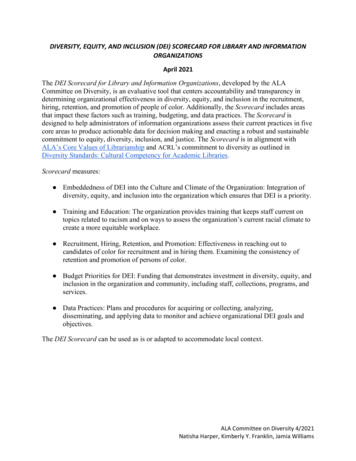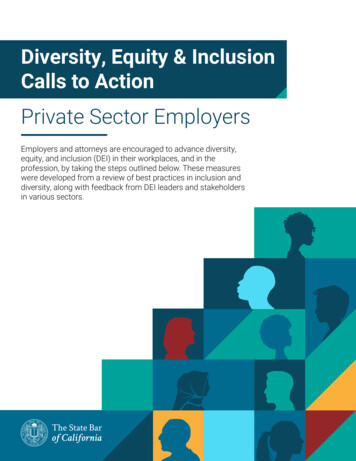
Transcription
Diversity, Equity & InclusionCalls to ActionPrivate Sector EmployersEmployers and attorneys are encouraged to advance diversity,equity, and inclusion (DEI) in their workplaces, and in theprofession, by taking the steps outlined below. These measureswere developed from a review of best practices in inclusion anddiversity, along with feedback from DEI leaders and stakeholdersin various sectors.
DEI Calls to Action: Private Sector EmployersPromote Transparencyand AccountabilityCollect and analyze demographic data on recruitment, hiring, promotion, and attrition. Provide staff whoreview demographic data a meaningful opportunity to recommend policy changes to your leadership team.y Compare data with other similar organizations. See e.g., 2021 NALP Report on Diversity in U.S. LawFirms.y Use the data to tailor specific interventions based on your organization’s size and geographic locationsto support diversity, equity, and inclusion (DEI) in recruitment, hiring, and promotion.y Analyze and share disaggregated data on turnover and retention rates.Update demographics measures.y At minimum, use State Bar demographics categories and study disaggregated data to avoid broadgeneralizations and enable more accurate analysis and policymaking.y Collect demographic data for all staff and board of directors, if applicable.Cultivate a workplace that encourages voluntary self-identification by all staff.Create a strategic DEI plan for your organization with timelines for specific objectives, metrics, andbenchmarks. Specify how to advance equity and inclusion. Include initiatives to support retention andadvancement, plans to regularly report and discuss progress, ways for attorneys and staff to providefeedback, and adequate staff resources to support these efforts.y Set equity and inclusion goals for specific programs and teams within the organization based oncommunities served.y For smaller organizations, collaborate with local and affinity bar associations, law school resources,and other similar-sized offices for support, ideas, and accountability regarding DEI practices.y Support retention and promotion from within; don’t rely solely on external lateral hires to meet diversitygoals.Establish regular forums for all staff to discuss and review progress made, as well as to share how tocontribute further to diversity and inclusion goals.Ensure staff at all levels have access to new and expanded resources to prioritize and implement yourorganization’s DEI plan.y Confirm that all leadership share the same commitment to DEI principles and objectives.y Establish (or support) senior-level DEI professional roles (e.g., chief diversity officer, director of DEI) thatcontribute to the organization’s strategic initiatives and decision-making. These roles should collaboratewith staff and spearhead efforts, not rely solely on existing staff with other primary responsibilities.y Compensate employee resource group (ERG) leaders or other DEI leaders who advance DEI effortsoutside of their stated job responsibilities.2
DEI Calls to Action: Private Sector EmployersMake available to all staff a broad range of professional development opportunities—including MinimumContinuing Legal Education training related to implicit bias, communications strategies, self-care,leadership training, mentoring, and other support—to develop a pipeline to leadership in your organization.Evaluate and modify, as needed, your orientation and onboarding process with an eye toward inclusion.Develop a statement that highlights your organization’s commitment to DEI and share it on your websiteand in recruiting materials.Communicate your demonstrated commitment to diversity and inclusion both internally and externally inthe workplace:y Communicate out to the entire organization about current and upcoming DEI initiatives. Everyoneshould be able to articulate the plans, process, and activities and be included, even if their job functionisn’t directly affected.y Update your organization’s website to be more inclusive, such as adding photos, names, and pronounson the staff webpage.y Inform staff about the importance of using individuals’ preferred pronouns. (See e.g., “InclusiveLanguage” resource at Pronouns Matter.)Create mechanisms to solicit and collect feedback, including stay and exit interviews and regular staffsurveys. Give staff reviewing this data a meaningful opportunity to recommend policy changes toleadership.y Focus stay and exit interviews on organizational culture, experience of inclusion and sense ofbelonging, as well as areas for improvement, such as assignment distribution, sponsorshipopportunities, and clearer pathways for advancement.y Collect data and insights on staff engagement expectations and reasons why staff may leave their jobs.y Use a DEI lens in reviewing interview responses and develop strategies to improve retention of diversestaff.y Survey staff regularly and ask what they value about their work. What is meaningful? Which parts of thejob make good use of their skills and abilities? Cultivate and expand those job functions.y Form a committee to solve problems identified in stay and exit interviews and staff surveys.Committees should develop accountability metrics to measure progress.Review your salary and compensation tables regularly to ensure they are equitable internally and reflect therelevant labor market.y Maintain transparency around salaries and discretionary bonuses to avoid masking compensationdisparities.y Standardize criteria and compensation tied to merit increases.y Hire a DEI consultant to review and identify any potential inequities if appropriate.y Participate in the annual American Bar Association’s (ABA) Model Diversity Survey to easily compareyour firm with other firms and employers from year to year. In-house legal departments should addressfirm hesitancy to participate in these surveys by making them an outside counsel hiring requirement.3
DEI Calls to Action: Private Sector EmployersBuild an InclusiveWorkplace CultureTake affirmative steps to develop and maintain an inclusive and equitable culture. Improve the workplaceexperience for all, regardless of gender identity, race/ethnicity, sexual orientation, disability status, orveteran status.y Develop formal policies and procedures for equitable work allocation that reflect your organization’sretention and advancement goals. Monitor work allocation to ensure equal opportunities with importantclients and cases.y Include DEI best practices into supervisors’ performance objectives. Educate supervisors on equitybased management skills.y Develop DEI-informed practices for supervision and performance evaluations (e.g., 360-degreeevaluations).y Create an environment that values work-life balance and supports staff well-being, including time forpersonal responsibilities.y Encourage pro bono work and allow it to count towards work time, or offer other incentives to increaseand support volunteer activities. Track pro bono hours separately from DEI time.y Provide stipends or other incentives to increase and support DEI and pro bono work and otherorganizational activities.Incorporate DEI work into performance evaluations and metrics that impact advancement andcompensation decisions. For example, allow DEI work to count toward billable hours.y Provide professional development time to volunteer to advance DEI in the legal profession such asmentoring underrepresented law students, speaking on panels about diversity in the law, and giving DEItrainings.y Encourage attorneys at your organization to participate in American Bar Association (ABA) Resolution102 by devoting at least 20 hours each year to advance and promote DEI in the legal profession.Develop policies and initiatives that promote staff’s sense of belonging.y Offer structured, intentional space at the office to discuss DEI and assess supervision, evaluation, andadvancement practices.y Develop and support ERGs, such as providing financial resources, allocating time for staff involvement,and encouraging leadership to participate as champions, sponsors, and advisers.y Encourage all staff to learn about and discuss DEI issues.y Become familiar with terms related to race, ethnicity, sexuality, gender, and other identities.y Require all staff to undergo annual training on implicit bias.y Provide avenues for confidential feedback and suggested improvements.4
DEI Calls to Action: Private Sector EmployersTie diversity goals to business growth objectives and opportunities.Collaborate with leadership and professional development organizations to offer structured opportunitiesto early and midcareer attorneys to partner in DEI.Diversify RecruitmentStrategies and PipelinesEnsure that new entry-level hires reflect the diversity of new State Bar licensees.Review updated demographic data for new licensees and other available DEI-focused reports annually toensure your organization is keeping pace.Identify and address any hiring traditions—recruiting strategies, hiring criteria, and processes—that maycontribute to a lack of diversity in your organization. These traditions may include focusing on law schoolrankings or judicial clerkships.Provide recruiters and interviewers with implicit bias training to equip them to manage their biases andchange behavior. Staff involved in hiring should strive to reduce the likelihood that bias will impact theirdecisions.Ensure that hiring committees include people from different backgrounds and experiences, as well as fromvarious practice areas and positions.Develop clear criteria and objective methods to assess applicants, including competency-based interviewquestions.y Structure interview panels and draft interview questions tied to specific job requirements andresponsibilities. Maintain consistent panels and questions from candidate to candidate. Use anaggregate scoring tool to lower the chance that one person’s biases can influence others.y Consider candidates holistically, looking at both legal and non-legal experiences, lived experiences, andcommitment to serving low-income and underserved communities, as appropriate.Ensure that recruiting materials are inclusive and welcoming of diverse communities.y Include salary ranges in job postings. A lack of transparency about salaries may obscure pay disparitiesamong staff.y Indicate on job postings your organization’s commitment to include DEI and racial justice principles inyour hiring process.y Inform potential clients or staff that training and legal practice will be from a racial justice lens, ifapplicable.y Share the organization’s demographic data with prospective candidates.5
DEI Calls to Action: Private Sector EmployersBuild relationships with law schools and affinity groups to broaden the applicant pool.y Post opportunities on public-facing websites and other appropriate publications, including those ofaffinity bar associations and law schools.y Participate in diversity job fairs (e.g., Bay Area Diversity Career Fair).Analyze the demographic data among your mid-level attorneys. Determine if it reflects the diversity of newlicensees from five to 10 years ago. If not, revisit your hiring strategies to determine whether your equityand inclusion goals are being prioritized.Offer paid diversity fellowship or scholarship programs to expand law student training and mentoringopportunities that establish paths to entry or employment (or opt into existing programs—see resourcesbelow).Retain, Advance,and Empower StaffBroaden benefit options based on learnings from remote- and hybrid-work models. Consider additionalbenefits that encourage wellness and self-care.Reinforce the importance of an approach to work that enhances well-being.y Options may include parental leave to non-birthing parents, benefits to temporary employees, onsite and remote ergonomic workspace assessments, and pre-tax health, childcare, and commutingbenefits.Ensure that organizational support resources and benefits are known and available to all staff.Identify and remedy supervision and promotion practices that may contribute to any diversity imbalances inyour organization’s leadership positions.Develop a plan with clear milestones and timeframes to support opportunities for advancement.Track staff training and professional development opportunities to ensure they are offered equitably, asappropriate, to staff at all levels.Assess your organization’s performance evaluations process to identify and reduce implicit bias. Retrainstaff on the improved process.6
DEI Calls to Action: Private Sector EmployersConsider mandating paid time to “unplug” to prevent employee burnout, during which staff will not checkemails, voicemails, or conduct any business. At least one large law firm instituted this measure, which alsoconferred physical and mental health benefits.Consider reducing caseloads or adjusting the hourly work week to increase flexibility.Develop a consistent process to attribute credit for engaging and retaining clients. In-house counsel canestablish requirements for credit when hiring outside counsel.Implement automatic bonuses, discretionary bonuses, and equity share opportunities.7
DEI Calls to Action: Private Sector EmployersResourcesPromote Transparency and AccountabilityFind more demographic data on law firms in the NALP Report on Diversity and the 2021 ABA ModelDiversity Survey.Pledge to support American Bar Association (ABA) Resolution 113. Participate in the annual ABA ModelDiversity Survey to easily compare your firm with other firms and employers year to year.Solicit demographic data from prospective candidates and current staff. Establish benchmarks to maintainconsistent and broad diversity in their candidate hiring and promotion pools, in the spirit of the MansfieldRule.Build an Inclusive Workplace CultureUse the Legal Aid Association of California’s Inclusion, Diversity, Equity, Accountability in Legal Aid (IDEAL)Toolkit to affect necessary DEI changes.Use respectful and inclusive language in all internal and external communications. (See e.g., the U.S.General Services Administration’s 18F Inclusive Language Guide and Microsoft’s Bias-Free CommunicationGuide.)Make the following resources available to help staff craft internal and external communications:y Asian American Journalists Association: Guidances and Resources.y National Association of Black Journalists Style Guide.y National Association of Hispanic Journalists: Cultural Competence Handbook.y National Center on Disability and Journalism Style Guide.Become familiar with terminology related to race, ethnicity, sexuality, gender, and other identities. Includethe Diversity Style Guide and the GLAAD Media Reference Guide in your organization’s staff resources.Inform staff about the importance of learning and using individuals’ preferred pronouns. (See e.g.,“Inclusive Language” at Pronouns Matter.)Propose a voluntary DEI challenge, such as anti-racism, for your team. Consider an anti-racism action planor the ABA-Wide 21-Day Racial Equity Habit-Building Challenge.8
DEI Calls to Action: Private Sector EmployersCreate through your own conduct an inclusive environment, where everyone feels that they belong and theircontributions are appreciated.y Learn how to identify and oppose the microaggressions, microinequities, and microinvalidations thatcan arise in day-to-day interactions with colleagues and the public.y Speak out against stereotype threats, implicit biases, and other similar phenomena.Challenge office dynamics that elevate the voices of one group, such as attorneys or certain sectors andindustries, over the voices of others.Participate in ABA Resolution 102 by encouraging attorneys to devote at least 20 hours each year toadvance and promote DEI in the legal profession.Authorize paid time to “unplug” to prevent burnout, during which staff won’t check emails, voicemails,or conduct any business. At least one large law firm took this a step further. It provided an extra week ofunplug time, which also conferred physical and mental health benefits.Create a sponsorship program and publicize widely throughout the firm. Clarify how mentorship andsponsorship differ and how each might apply in various practice settings.Diversify Recruitment Strategies and PipelinesReview the updated demographic data for new licensees annually from the State Bar’s Diversity ReportCard.Refer to a list of affinity bar associations (e.g., the California Lawyers Association’s list) and diversitycommittees of bar associations for outreach opportunities.Retain, Advance, and Empower StaffSee the ABA publication, “Practicing Law in the Pandemic and Moving Forward.”9
Diversity, Equity & Inclusion Calls to Action . Private Sector Employers . Employers and attorneys are encouraged to advance diversity, equity, and inclusion (DEI) in their workplaces, and in the profession, by taking the steps outlined below. These measures were developed from a review of best practices in inclusion and

